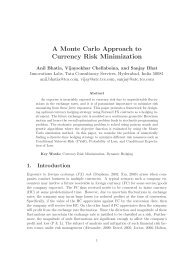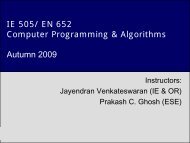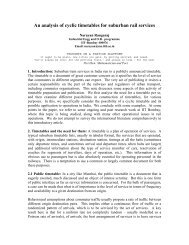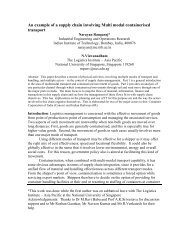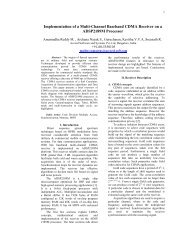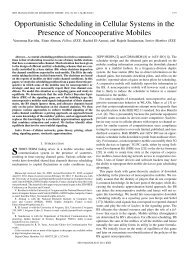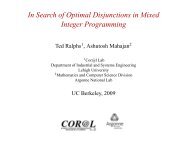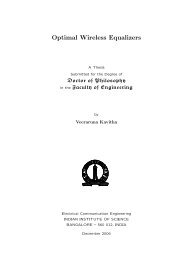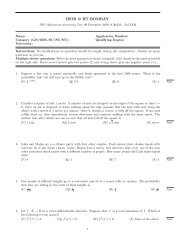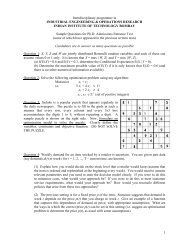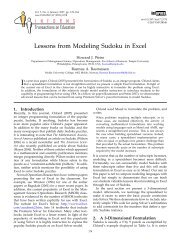Presolving Mixed-Integer Linear Programs - COR@L
Presolving Mixed-Integer Linear Programs - COR@L
Presolving Mixed-Integer Linear Programs - COR@L
You also want an ePaper? Increase the reach of your titles
YUMPU automatically turns print PDFs into web optimized ePapers that Google loves.
<strong>Presolving</strong><strong>Mixed</strong><strong>Integer</strong> <strong>Linear</strong><strong>Programs</strong> 11<br />
• Knapsack inequalities including 0-1 knapsack, mixed 0-1 knapsack, integer knapsack, and<br />
mixed-integerknapsack inequalities(Atamtürk,2005).<br />
• Generalized upper bound constraints can be used to generate valid inequalities (Wolsey,<br />
1990).<br />
• Variable lower bound and upper bound constraints can also be used to generate valid inequalities(vanRoy<br />
and Wolsey,1987).<br />
5 Postsolve<br />
After an instance has been treated by a presolver and then solved, the user may ask for the solution<br />
and other problem characteristics. The presolvercan change some instance substantially and<br />
the solution of the transformed problem may be quite different from that of the original problem.<br />
Hence the presolve routines are designed to save the changes that were made to the original instance.<br />
Andersenand Andersen (1995) suggest keeping a “stack” of all the transformations that<br />
were made by the presolver and reverting them in a last-in-first-out sequence. Sometimes, the<br />
solutionobtainedbyrevertingthechangesmaynotremainfeasibleforthespecifiedtolerancevalues<br />
even though the presolved solution was feasible. In such cases, the user must either decrease<br />
the tolerance limitor disablepresolve.<br />
6 ConcludingRemarks<br />
In this paper, we have surveyed many techniques for presolving. Some of these techniques are<br />
simple, like removing empty constraints, and empty columns, identifying special structures and<br />
rearranging constraints and variables. Some others are more powerful, like detecting duplicate<br />
rows and columns. They require specialized algorithms to avoid spending excessive amount of<br />
time. Then there are some methods like bound tightening, detecting infeasibility and identifying<br />
redundant constraints which in theory can be as difficult as solving the original problem itself.<br />
Heuristic methods are used to trade off the time spent in these problems against the benefits<br />
of solving them. All of these methods usually consider only bounds on variables and a single<br />
constraint. Advancedpresolvingmethodscanhelpsimplifyingtheproblemsalotbuteachprobe<br />
requires repeating basic presolving methods. Further, one needs to probe over many candidate<br />
variables. Ingeneral,itisdifficulttopredicttheoptimaleffortthatshouldbeputintoeachmethod<br />
of presolving. Most implementations of a presolver rely on several rules of thumb and the past<br />
experienceswith thesemethods.<br />
A presolver is an important component of modern MILP solvers. It can substantially reduce<br />
the time taken to solve MILPs. It is also useful for conveying to the user obvious problems with<br />
the formulation of the instance. However, the percentage of time spent by a solver in presolve<br />
routinesisusuallymuchsmallerthanthepercentageoflinesofcoderequiredtowriteapresolver.



